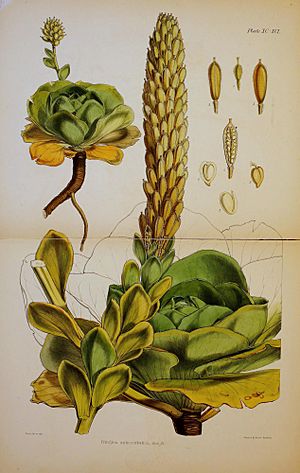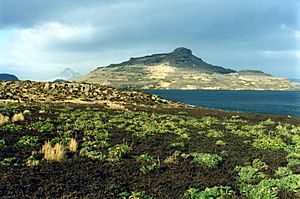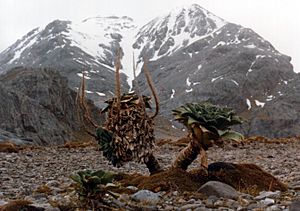Kerguelen cabbage facts for kids
Quick facts for kids Kerguelen cabbage |
|
|---|---|
 |
|
 |
|
| Scientific classification | |
| Genus: |
Pringlea
|
| Species: |
antiscorbutica
|
The Pringlea antiscorbutica, often called Kerguelen cabbage, is a special flowering plant. It's the only plant in its group, called the Pringlea genus, and it belongs to the Brassicaceae plant family.
Its common name, Kerguelen cabbage, comes from the Kerguelen Islands where it was first found. The plant's scientific name, Pringlea, honors Sir John Pringle, who was the head of the Royal Society when Captain James Cook's surgeon, William Anderson, discovered the plant in 1776. The second part of its scientific name, antiscorbutica, means "against scurvy" in Low Latin. This is because the plant was very helpful for sailors who suffered from scurvy.
What it Looks Like
Kerguelen cabbage plants have groups of leaves that can spread out up to 45 centimeters (about 18 inches) wide. These leaves grow on top of strong, woody stems that can be about 15 centimeters (6 inches) thick and up to 1 meter (3 feet) long. The stems that hold the flowers stay on the plants for many years.
Where it Grows
This unique plant grows on very remote islands in the southern parts of the world. You can find it on Heard Island and McDonald Islands, the Crozet, Prince Edward, and Kerguelen Islands. Scientists believe that the plant's ancestors probably traveled from South America about five million years ago to reach these distant islands.
How it Lives
The islands where Kerguelen cabbage lives are around 50° South Latitude. This means they are constantly hit by very strong winds. These windy conditions make it hard for plants to be pollinated by wind, except on rare calm days. Also, there are almost no insects on these islands that could help with pollination. Because of this, the Kerguelen cabbage has learned to self-pollinate. This means it can pollinate itself without needing wind or insects.
These plants usually grow to about 50 centimeters (20 inches) wide in about four years. They start to flower for the first time when they are three or four years old. When they are fully grown, Kerguelen cabbage plants have special ways to deal with the cold. For example, they have high levels of certain chemicals called polyamines, which help them survive freezing temperatures. The leaves of Pringlea also hold a lot of water (more than 83%). Water can easily move from the roots to the leaves, which is good because the soil on these islands is always very wet. This also means it's quite difficult to grow this plant successfully in other places.
Uses of the Plant
The Kerguelen cabbage is safe to eat and is full of potassium. Its leaves contain an oil rich in vitamin C. This was very important for sailors on long voyages who often suffered from scurvy, a serious illness caused by not enough vitamin C. This is why the plant's scientific name includes antiscorbutica, meaning "against scurvy." It was a vital food source for whalers on the Kerguelen Islands when they ran out of other meats like pork, beef, or seal meat.
In May 1840, a botanist named Joseph Dalton Hooker was the first to study the plant in detail and give it its Latin name. Hooker also wrote about eating soup made with Kerguelen cabbage. He said the raw leaves tasted like garden cress, the boiled leaves tasted like "stale" cabbage, and the root tasted like horseradish.
Conservation
A type of fly called Calycopteryx mosleyi is often found living near this plant. Unfortunately, rabbits were brought to the Kerguelen Islands around 1874. These rabbits eat the cabbage, so now the plant can only be found in places where rabbits cannot reach. Luckily, rabbits are not present on all the islands where the Kerguelen cabbage grows.
See also
 In Spanish: Col de Kerguelen para niños
In Spanish: Col de Kerguelen para niños



